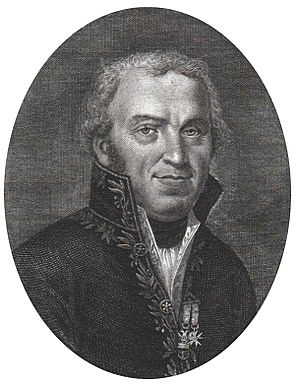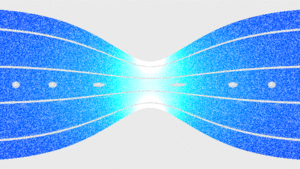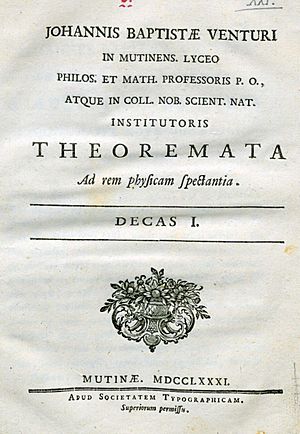Giovanni Battista Venturi facts for kids
Quick facts for kids
Giovanni Battista Venturi
|
|
|---|---|
 |
|
| Born | 15 March 1746 Bibbiano
|
| Died | 24 April 1822 (aged 76) |
| Known for | Venturi effect |
Giovanni Battista Venturi (born September 11, 1746 – died September 10, 1822) was a smart Italian scientist. He was a physicist, writer, and even a diplomat. He is most famous for discovering something called the Venturi effect. This effect explains how fluids (like liquids or gases) move and change pressure when they flow through a narrow space.
Venturi described his discovery in 1797. Because of his work, many important tools are named after him. These include the Venturi tube, the Venturi flow meter, and the Venturi pump. These tools are used to measure or control how fluids flow.
Contents
Venturi's Early Life and Career
Giovanni Battista Venturi was born in Bibbiano, Italy. This was in the Province of Reggio Emilia. He grew up to be a very bright student. He learned from famous scientists like Lazzaro Spallanzani.
In 1769, when he was 23, Venturi became a priest. In the same year, he started teaching logic at a school in Reggio Emilia. By 1774, he was a professor at the University of Modena. There, he taught geometry and philosophy.
Venturi also worked for the Duke of Modena. He was the Duke's mathematician and an engineer. As an engineer, he helped build bridges and manage water systems. He also set rules for building dams. In 1786, he became a professor of experimental physics at the University of Modena. He set up a modern laboratory there.
Understanding Fluid Mechanics

Venturi later traveled to Paris, France. He went there as part of a group sent by the Duke of Modena. After his official duties, he stayed in Paris for a year and a half. He wanted to learn more about physics and chemistry.
In Paris, Venturi met many important scientists. These included Georges Cuvier and Pierre-Simon Laplace. While there, he published his famous paper on the "Venturi effect" in 1797.
However, Venturi's ideas were not used in a practical device right away. It wasn't until 1888 that Clemens Herschel created the first commercial Venturi tube. This device used Venturi's principles to measure fluid flow.
Venturi as a Science Historian
Venturi was also a great historian of science. He was the first to show how important Leonardo da Vinci was as a scientist. Before Venturi, most people only saw Leonardo as an artist. In 1797, Venturi wrote a small book about Leonardo's science work. He also studied hydraulics (the science of water movement) with Leonardo's ideas.
Jérôme Lalande, a famous astronomer, told General Napoleon Bonaparte about Venturi. He said Venturi was one of the best people to help Italy with science and engineering. Napoleon was impressed. He made Venturi a member of the French government. He also made him a professor at the Military School of Modena. Venturi even received a special honor called the Legion of Honour.
Venturi faced some challenges in his life. But Napoleon helped him keep his position at the University. After Napoleon took control of Italy, he gave Venturi a professorship at the University of Pavia. Venturi also worked on mining and water projects.
Later, Venturi worked as a diplomat in Switzerland for twelve years. He retired in 1813 because he was not well. Napoleon gave him a good pension. When he returned to Reggio, he published more scientific and literary works.
In 1814, Venturi wrote about the history of optics (the study of light). He also collected and published many of Galileo's writings and letters between 1818 and 1821. Venturi was also the first to recognize Leonardo da Vinci's work on tribology. This is the study of friction, wear, and lubrication. He found Leonardo's notes on this topic, which had been moved to Paris.
Giovanni Battista Venturi passed away in Reggio Emilia in April 1822. He was 76 years old.
Works
See also
 In Spanish: Giovanni Battista Venturi para niños
In Spanish: Giovanni Battista Venturi para niños



